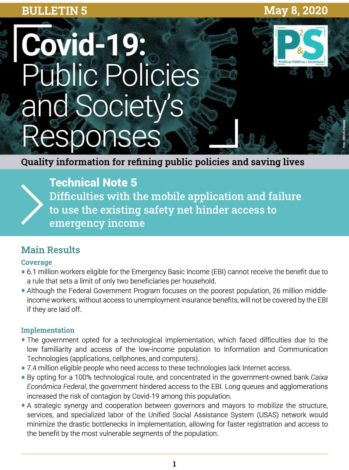Main Results Coverage
- 6.1 million workers eligible for the Emergency Basic Income (EBI) cannot receive the benefit due to a rule that sets a limit of only two beneficiaries per household.
- Although the Federal Government Program focuses on the poorest population, 26 million middleincome workers, without access to unemployment insurance benefits, will not be covered by the EBI if they are laid off.
Implementation
- The government opted for a technological implementation, which faced difficulties due to the low familiarity and access of the low-income population to Information and Communication Technologies (applications, cellphones, and computers).
- 7.4 million eligible people who need access to these technologies lack Internet access.
- By opting for a 100% technological route, and concentrated in the government-owned bank Caixa Econômica Federal, the government hindered access to the EBI. Long queues and agglomerations increased the risk of contagion by Covid-19 among this population.
- A strategic synergy and cooperation between governors and mayors to mobilize the structure, services, and specialized labor of the Unified Social Assistance System (USAS) network would minimize the drastic bottlenecks in implementation, allowing for faster registration and access to the benefit by the most vulnerable segments of the population.
Work group responsible
Coordination: Rogério Jerônimo Barbosa (Centro de Estudos da Metrópole-CEM, USP) e Ian Prates (CEBRAP, Social Accountability International)
Researchers:
- Carolina Requena (CEM)
- Eduardo Lazzari (USP, CEM)
- Hellen Guicheney (CEM, CEBRAP)
- Heloisa Fimiani (USP)
- Jefferson Leal (USP)
- Paulo Flores (USP)
- Sergio Simoni (UFRGS)
- Thiago Meireles (USP)
- Vitor Menezes (USP, CEBRAP)
Consultants
- Renata Bichir (USP)
- Flávio Cireno (Fundação Joaquim Nabuco)
Contributions
- Fábio Senne e Equipe Nic.br


